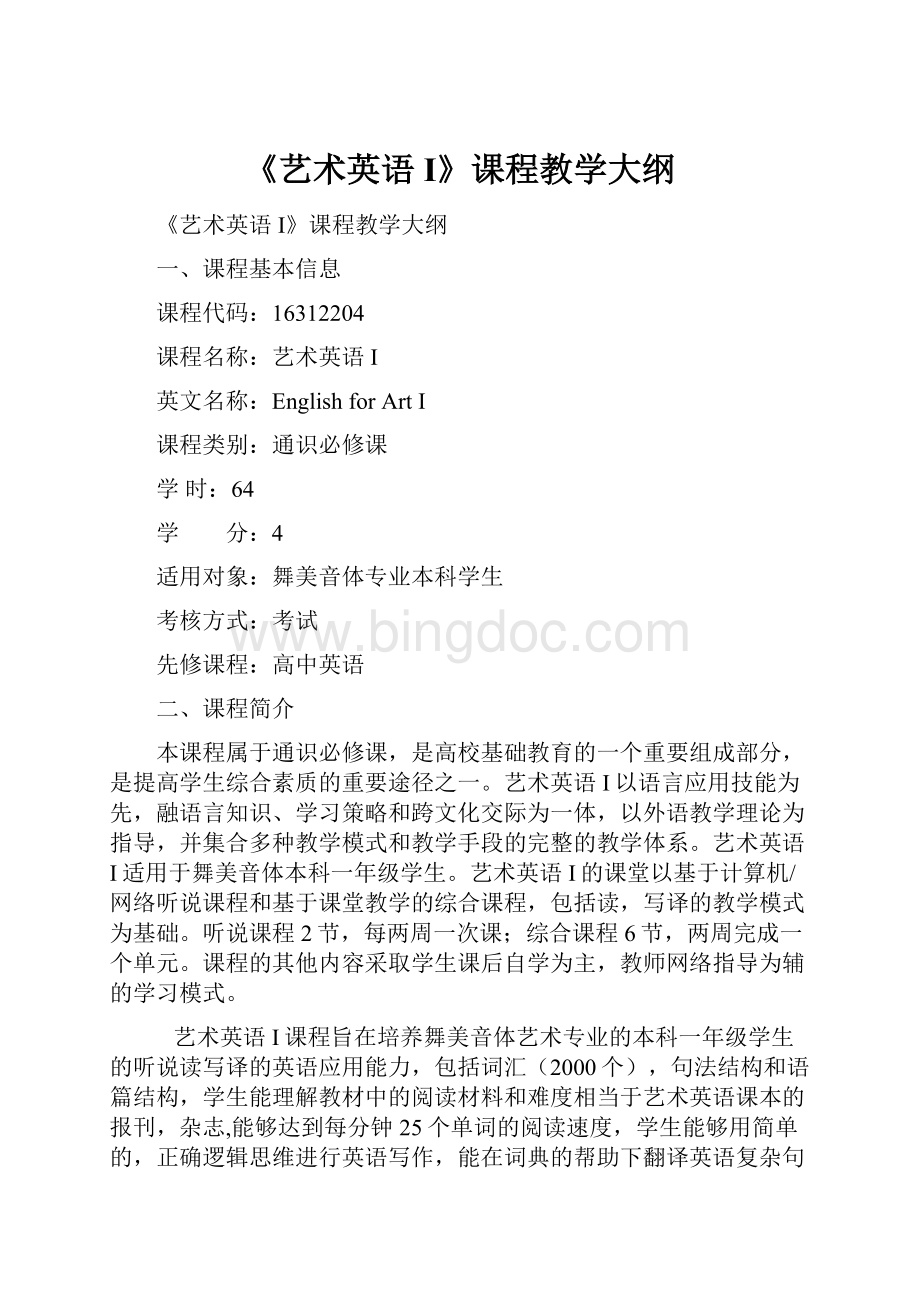《艺术英语I》课程教学大纲.docx
《《艺术英语I》课程教学大纲.docx》由会员分享,可在线阅读,更多相关《《艺术英语I》课程教学大纲.docx(29页珍藏版)》请在冰点文库上搜索。

《艺术英语I》课程教学大纲
《艺术英语I》课程教学大纲
一、课程基本信息
课程代码:
16312204
课程名称:
艺术英语I
英文名称:
EnglishforArtI
课程类别:
通识必修课
学时:
64
学 分:
4
适用对象:
舞美音体专业本科学生
考核方式:
考试
先修课程:
高中英语
二、课程简介
本课程属于通识必修课,是高校基础教育的一个重要组成部分,是提高学生综合素质的重要途径之一。
艺术英语I以语言应用技能为先,融语言知识、学习策略和跨文化交际为一体,以外语教学理论为指导,并集合多种教学模式和教学手段的完整的教学体系。
艺术英语I适用于舞美音体本科一年级学生。
艺术英语I的课堂以基于计算机/网络听说课程和基于课堂教学的综合课程,包括读,写译的教学模式为基础。
听说课程2节,每两周一次课;综合课程6节,两周完成一个单元。
课程的其他内容采取学生课后自学为主,教师网络指导为辅的学习模式。
艺术英语I课程旨在培养舞美音体艺术专业的本科一年级学生的听说读写译的英语应用能力,包括词汇(2000个),句法结构和语篇结构,学生能理解教材中的阅读材料和难度相当于艺术英语课本的报刊,杂志,能够达到每分钟25个单词的阅读速度,学生能够用简单的,正确逻辑思维进行英语写作,能在词典的帮助下翻译英语复杂句。
通过听说课程的学习,学生能够领会标准的英语录音的句子,情景对话和英语发音,要求掌握英文句子听写介绍简单的英语句,能运用简单英语进行讨论和对话。
艺术英语I课程是培养艺术专业本科一年级学生听说读写译综合运用英语进行信息交流的能力,使他们在今后工作和社会交往中能用英语有效地进行口头和书面的信息交流,同时增强其自主学习能力,提高综合文化素养,以适应我国社会发展和国际交流的需要。
艺术英语I课程的教学评估包括形成性评估和终结性评估。
EnglishforArtIisanobligatorygeneralcourseforthenon-English-majorundergraduateartstudentsofGuangdongUniversityofFinanceandEconomics.Itisanintegratedpartoftheteachingplanforthenon-Englishundergraduateartmajorintheuniversityandacoursedesignedtoimprovethegeneralhumanityqualityofthestudents.TheclassroomteachingofCourseofEnglishforArtImainlyincludescomputer-basedlisteningandspeakingcourseandclassroom-basedintegratedcourseofreading,writingandtranslation.Theformeroccupies2periodseveryotherweek,whilethelattertakes2periodsforeverytwoweeks.Therestofthecontentsintextbooksaretobeself-studiedafterclasswithteacherscoachingthemon-line.
EnglishforArtIaimstodevelopstudents’abilitiestolearncorrespondinglanguageandpragmaticskillsincludingVocabulary(2000words).syntacticstructuresaswellastextualstructures,tounderstandthereadingmaterialsaswellasEnglishnewspapersandmagazineswiththesimilardegreeofdifficultytothosepassagesinthetextbooksataspeedof25wordsperminute,beabletowritesimpleEnglishsentenceswithcorrectgrammarandproperlogic,andtotranslateEnglishsentenceswithmultipleclausesintoChineseandviceversa,withthehelpwithdictionaries.Throughlisteningandspeaking,studentsshouldbeabletounderstandstandardrecordedEnglishsentences,dialoguesandspeechespronounced,takedictationsonsimpleEnglishsentences,introducethemselvesinEnglish,andtakepartindiscussionsormakedialoguesusingsimpleEnglish.
EnglishforArtIalsoaimstodevelopstudents’abilitytouseEnglishinanall-roundwaysothatintheirfutureworkandsocialinteractionstheywillbeabletoexchangeinformationeffectivelythroughbothspokenandwrittenchannels,andatthesametimetheywillbeabletoenhancetheirabilitytostudyindependentlyandimprovetheirculturalqualitysoastomeettheneedsofChina’ssocialdevelopmentandinternationalexchanges.
TheevaluationofEnglishforArtIconsistsofbothformativeassessmentandsummativeassessment.
三、课程性质与教学目的
艺术英语I级课程是为广东财经大学非英语专业的艺术类专业本科一年级学生开设的一门语言技能基础课程,是广东财经大学非英语专业教学计划的一个有机组成部分,是一门提高艺术专业学生综合人文素养的重要课程。
艺术英语I级课程的学习,既是学生通过英语学习和实践活动逐步掌握英语知识和技能,提高语言实际运用能力的过程,又是他们陶冶情操,丰富人生经验,开发辩证思维能力和提高人文素养的过程。
它有助于学生拓展视野,扩大知识面,加深对世界的了解,借鉴和吸收优秀的外国文化精华,提高文化素养。
艺术英语II课程是以英语语言知识与应用技巧,学习策略和跨文化交际为主要内容,以外语教学理论为指导,并集多种教学模式和教学手段为一体的教学体系。
艺术英语I级课程教学目的是:
通过教师的“精讲”和学生的“多练”通过听说读写译全方位的各种形式的课堂内外的实践,以多媒体技术为教学手段之一,培养学生的阅读能力和听说能力,使他们能够运用英语交流信息,打下扎实的语言基础,掌握良好的语言学习方法,提高文化素养,培养持续的自学能力,适应社会的需求和发展。
艺术英语I级课程目标是能听懂发音清晰,节奏缓慢,语音标准的录音句子,熟悉话题的录音短文,能够听懂用简单英语进行的课堂讨论,能借助视频和字幕听懂电影对白的主要意思。
能用简单的英语口头描述人物,个人经历,朋友交往,生活学习场景,日常事物,个人喜好,能在课堂讨论中用英语发表自己的简单见解,能读懂和艺术英语II级相当难度的英文报刊和杂志。
能用简单连贯的英语书面表达熟悉题材的内容,能写出故事连贯的记叙文(50词左右)。
能多渠道获取英语信息,能体会视听材料和书面材料中的跨文化信息。
学会辨析中西方艺术文化对比,培养中华民族自信,加强爱国主义教育,树立正确世界观和价值观。
四、教学内容及要求
精读部分
Unit1
(一)目的与要求
Studentsareexpectedto
1.understandthemainideaoftextAandB,learntoknowaboutthementalstatesandissuesofthefreshmenoncampus;
2.masterthekeyworldsandexpressionsandsentencespatterns(thenegativesentences,sentenceofrealcondition,andsentenceofquestion);
3.graspthedifferentpronunciationofshortvowel[i]andlongvowel[i:
];
4.appreciatetheprofoundinfluenceofChineseculturesanddeepthoughtsofConfucius
(二)教学内容
1.主要内容
1)TextAYourfirstnightatschool.
2)Warm-upActivities(MatchingandConversation)
3)TextA
4)Backgroundinformation(SAT,NCAA)
5)languagePoints
6)SuggestedQuestions
7)AdditionalMaterials
8)Afterclassreading:
TextBNevertoooldtoliveupyourdreams?
2.基本概念和知识点
1)Keywords(dormitory,gymnasium,library,classroombuilding,canteen,lecturehall)
2)LanguagePoints
a.Survive:
(Idon’tthinkIcouldsurviveanotheryearasateacher;it’sjusttoostressful.)
b.It’salittleweird,isn’tit?
(反义疑问句强调句子的前半句)
c.Social:
(Thesocialweattendedlastnightwasverysuccessful.)
d.Thefirstweekisgoingtobeawhirlwind,buttakeadvantageoftheenergywhileyouhaveit.(这是一个并列复合句,前一个分句用了一个隐喻,后一个分句是个祈使句。
)
e.lifelong(He’sgotalifelongfascinationwiththesea)
3)Questionsanswering
Isiteasytoentercollege?
Howdoyoufeelwhenyouarefinallyincollege?
Whyshouldyougetgoodnightofsleeponyourfirstnightatcollege?
Whataretheauthor’ssuggestionstoyouforthefirstweekofyourcollegedays?
Howwillthenextfewdaysbe?
4)WritingstyleandSummary
3.问题与应用(能力要求)
1)Listeningandspeaking
2)Readingcomprehension
3)Analyzingthesentencespatterns
4)Writingabilityandwritingstructure
5)Summary
6)Grammar
(三)思考与实践
ContentQuestions(Pairwork)
PointsforDiscussions(Groupwork)
TextOrganization
LanguageSenseEnhancement
LanguageFocus:
Vocabulary;Usage,Structure;clauses,translation
HomeReading(TextB)andExercises
Self-assessmentlistening
ListingandSpeaking:
HomeListening,SpeakingTasks,Pairwork
(四)教学方法与手段
课堂讲授,课堂讨论,多媒体,网络学习,自主学习
Unit2
(一)目的与要求
Studentsareexpectedto
1.understandthemainideaoftextAandB,learntoknowaboutthemusician’shighspiritsofpursuingperfect;
2.masterthekeyworldsandexpressionsandsentencespatterns;
3.graspthedifferentpronunciationofvowel[e]andlongvowel[e:
];
4.learnhowtouseNounsproperly;
5.appreciatethefriendshipsbetweenmusicians.
(二)教学内容
1.主要内容
TextATheOperaSigner
1)Warm-upActivities(MatchingandConversation)
2)TextA
3)Backgroundinformation(PedroPabloSacristan,HistoryofOpera)
4)languagePoints
5)SuggestedQuestions
6)AdditionalMaterials
7)Afterclassreading:
TextBPlayaViolinwithThreeString
2.基本概念和知识点
1)Keywords(violin,bass,saxophone,cello,flute,dulcimer)
2)LanguagePoints
a.matter:
(It’snolaughingmatter.Howdidmattersstand?
)
b.Whatmadehimmostunusual,though,wasthefactthatwheneverheneededtocommunicatehediditbysingingopera.
这个句子包含一个由what引导的从句做句子的主语和一个由that引导的复合句做fact的同位语。
c.clear:
(Heclearedthisthroatandbegansinging.)
d.Itwouldn’tbeunfairtosaythatalmosteveryoneconsideredWilliamWarbleramassivepainintheneck.
这是双重否定表肯定的句子。
3)Questionsanswering
WhatmadeWilliamWarblerdifferentfromothers?
DidanyoneknowwhatWilliam’sjobwas?
WhatclothesdidWilliamusuallywear?
Whatwastherumorabout?
WhydidWilliamsingwhilecommunicatingwithothers?
4)WritingstyleandSummary
3.问题与应用(能力要求)
1)Listeningandspeaking
2)Readingcomprehensions
3)Analyzingthesentencespatterns
4)Writingabilityandwritingstructure
5)Summary
(三)思考与实践
ContentQuestions(Pairwork)
PointsforDiscussions(Groupwork)
TextOrganization
LanguageSenseEnhancement
LanguageFocus:
Vocabulary;Usage,Structure;clauses,translation
HomeReading(TextB)andExercises
Self-assessmentlistening
ListingandSpeaking:
HomeListening,SpeakingTasks,Pairwork
(四)教学方法与手段
课堂讲授,课堂讨论,多媒体,网络学习,自主学习
Unit3
(一)目的与要求
Studentsareexpectedto
1.understandthemainideaoftextAandB,learntoknowaboutthefashiontendency;
2.masterthekeyworldsandexpressionsandsentencespatterns(Itis…that…);
3.graspthedifferentpronunciationofvowel[e]andlongvowel[ei];
4.learnhowtouseVerb(I)properly;
5.appreciatethehistorydevelopmentofChinesecheongsam.
(二)教学内容
1.主要内容
TextAFashionForest
1)Warm-upActivities(MatchingandConversation)
2)TextA
3)languagePoints
4)SuggestedQuestions
5)AdditionalMaterials
6)Afterclassreading:
TextBLearntoLovewithCurlyHair
2.基本概念和知识点
1)Keywords(suit,shirtandbowtie,Chinesetunicsuit,cheongsam,eveningdress,T-shirtandjeans)
2)LanguagePoints
a.Comeby:
(Shecamebythehouse.)
b.Onceuponatime,therewasaforestwherealltheanimalslivedhappilytogether.
这是一个复合句,主句为therewasaforest,后面由where引导的是定语从句,修饰aforest.
c.fit:
(Theclothesfitmewell)
d.Snag(Isnaggedmysweateronthewirefence)
e.Eventheraccoon,thankstohisbrightlycoloredsocks,slippedfromoneoftheriverrocksandalmostdrowned.插入语,前后用逗号隔开,去掉不影响句子的完整性。
3)Questionsanswering
Howdidtheraccoongetapairofsocks?
Whydidn’ttheraccoonwanttotakeoffthesocks?
Whydidsomeotheranimalsstarttowearclothesandotherthings?
Didtheanimalsbenefitfromthefashionfever?
WhatwastheprescriptiongivenbyDoctorBear?
4)WritingstyleandSummary
3.问题与应用(能力要求)
1)Listeningandspeaking
2)Readingcomprehensions
3)Analyzingthesentencespatterns
4)Writingabilityandwritingstructure
5)Summary
(三)思考与实践
ContentQuestions(Pairwork)
PointsforDiscussions(Groupwork)
TextOrganization
LanguageSenseEnhancement
LanguageFocus:
Vocabulary;Usage,Structure;clauses,translation
HomeReading(TextB)andExercises
Self-assessmentlistening
ListingandSpeaking:
HomeListening,SpeakingTasks,Pairwork
(四)教学方法与手段
课堂讲授,课堂讨论,多媒体,网络学习,自主学习
Unit4Arts
(一)目的与要求
Studentsareexpectedto
1.understandthemainideaoftextAandB,learntot